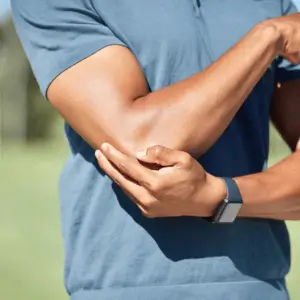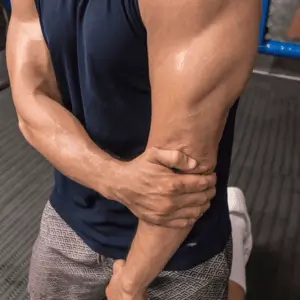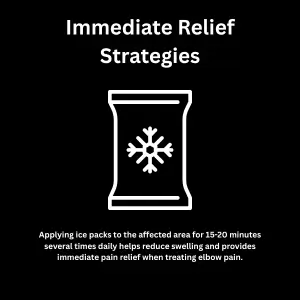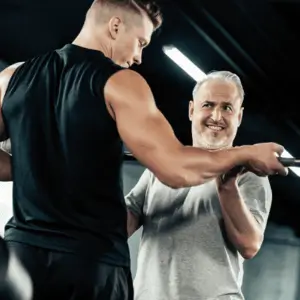Are you experiencing elbow pain when lifting weights at your local Forney gym? You’re not alone. Many fitness enthusiasts in our community struggle with this common but frustrating issue.
Elbow pain can quickly transform your favorite workout from a source of joy to a dreaded experience. What starts as mild discomfort can evolve into a persistent problem that affects not just your gym time but your everyday activities.
Fortunately, effective solutions are available right here in Forney. Our specialized sports physical therapy services can help you overcome elbow injuries and get back to your fitness routine without pain.
The Growing Problem of Elbow Pain in the Fitness Community

Weightlifting is a cornerstone of physical fitness for many Forney residents. From high school athletes training at local schools to adults working out at community fitness centers, elbow strength training offers tremendous benefits for overall health.
But with the increasing popularity of weight lifting in our community comes a rise in overuse injuries. The elbow joint, a complex joint that connects your upper arm to your forearm, is particularly vulnerable to strain during lifting activities.
Each week, we meet residents who can no longer participate in local fitness events or train effectively because elbow pain has sidelined them from their fitness goals.
Understanding Why Your Elbow Hurts When Lifting
Your elbow functions as a complex joint where several arm muscles and elbow tendons connect. When you lift weights, these structures work together to generate force and stability.
Repetitive movements involved in weight lifting can create tiny tears in the tendons where forearm muscles attach to the bony bumps of your elbow. This damaged tissue becomes inflamed, causing pain and limiting your ability to train effectively.
Poor lifting technique at your local gym or trying to progress too quickly with heavier weights can exacerbate these problems and lead to chronic pain conditions and overuse injuries.
Common Types of Elbow Pain Among Weightlifters
Tennis Elbow (Lateral Epicondylitis)

Despite its name, tennis elbow affects many weightlifters in our community. This condition involves inflammation where the forearm muscles attach to the lateral epicondyle, the bony bump on the outside of the elbow, and can sometimes cause pain toward the inner elbow as well.
Tennis elbow affects your ability to grip weights. Many clients report that their pain intensifies when performing pulling exercises or using barbells during their workouts, much like what happens when playing tennis.
The repetitive stress of certain lifting movements causes the tendons to become slightly swollen and irritated, making even light athletic activity painful and causing tennis elbow. It is crucial to work with a specialist who can diagnose tennis elbow helps prevent further strain.
Golfer’s Elbow (Medial Epicondylitis)
Known as medial epicondylitis in medical terms, golfer’s elbow creates pain on the inner side of your elbow where tendons connect to the medial epicondyle. This inner elbow pain is common among weightlifters who frequently perform pulling exercises or curls.
Symptoms include medial elbow pain, forearm discomfort, and decreased grip strength. Many Forney residents notice this pain most when doing their regular workout routines.
The repetitive strain from these movements creates inflammation in the affected area, making it difficult to maintain your regular training schedule.
How Elbow Pain Is Disrupting Active Lifestyle
Living with elbow pain means more than just discomfort during workouts. For many residents, it means:
Missing team training sessions with local fitness groups because the pain makes it impossible to participate fully—especially for those dealing with tennis elbow or golfer’s elbow, which are common in repetitive arm use.
Struggling with everyday tasks like carrying groceries or lifting your children at local parks becomes a real challenge when tennis elbow or golfer’s elbow flare up, making even simple movements painful.
Abandoning fitness goals you’ve worked hard to achieve, especially when conditions like tennis elbow and golfer’s elbow make weightlifting, yoga, or even jogging uncomfortable, leading to frustration and decreased quality of life.
Tennis elbow and golfer’s elbow can both cause shooting pain or stiffness that interrupts your form during exercises, causing some people to avoid the gym entirely out of fear of worsening their injury.
The longer you ignore these symptoms of tennis elbow, the more likely they are to develop into a repetitive strain injury like tennis elbow or golfer’s elbow that requires extensive treatment and recovery time.
For fitness-focused residents, understanding the early signs of tennis elbow and golfer’s elbow is crucial to maintaining an active, healthy lifestyle without long-term setbacks.
Treatment Solutions for Elbow Pain
Immediate Relief Strategies

Applying ice packs to the affected area in the elbow for 15-20 minutes several times daily helps reduce swelling and relieve pain when treating elbow pain. Ice packs are effective after returning from their regular workout sessions, especially when dealing with tennis elbow.
Taking over the counter anti-inflammatory medications temporarily can help manage inflammation and relieve pain during the acute phase of your elbow injury. These medications are commonly used to treat conditions like tennis elbow, which involve inflammation of the tendons in the elbow.
Using an elbow brace during workouts or daily activities provides support to the injured area and can prevent further strain while tissues heal. This is particularly beneficial for individuals suffering from tennis elbow.
Tennis elbow often develops from repetitive elbow motions, especially in sports like tennis or activities involving heavy lifting or gripping. If you’re experiencing persistent elbow pain in Forney, there’s a chance it may be tennis elbow. Recognizing the symptoms early allows for faster recovery and less disruption to your daily routine.
Many of the strategies mentioned above are effective not only for general elbow pain but also for treating tennis elbow and golfer’s elbow. Whether you’re an athlete or someone dealing with repetitive strain from work, early treatment for tennis elbow is key to staying active and pain-free.
Professional Physical Therapy Solutions
Our physical therapists specialize in evaluating tennis elbow, golfer’s elbow, and other elbow problems through careful assessment. We examine not just your elbow but your entire biomechanical chain to identify contributing factors, working in conjunction with your physician’s diagnosis when needed.
Strengthening exercises for the elbow, forearm muscles and shoulder exercises to improve arm stability form the cornerstone of our rehabilitation programs.
Hands-on techniques promote healing of the affected tendons.
Advanced Treatment Options
For persistent cases that don’t respond to conservative treatment after four to six weeks, specialized treatments like steroid injections might be considered. These can reduce pain in specific situations, especially when inflammation affects both the lateral and medial epicondyle areas. Your physical therapist can discuss if a referral to an orthopedic specialist is appropriate.
In rare cases where severe pain persists, a surgical consultation might be considered. This is recommended after exhausting non-surgical options, such as over the counter medications and the decision would be made in coordination with an orthopedic specialist who may suggest surgery.
Research suggests that most patients experience significant improvements with proper rehabilitation. The majority of elbow tendinopathy cases, even those caused by playing sports or repetitive motion, can be successfully managed without other treatments, even if you still experience pain.
Preventing Elbow Injuries: Strategies for Weightlifters
Perfect Your Form

Proper form is crucial to prevent tennis elbow and other elbow injuries. Consider booking sessions with certified local trainers who understand biomechanics and can correct positioning issues.
Focus on engaging larger muscle groups rather than isolating smaller ones, especially when first learning new movements.
Many elbow issues stem from improper lifting techniques that place repetitive stress on these vulnerable tendons.
Progressive Training
Increase weights gradually instead of making dramatic jumps when lifting objects. Our local athletes often find that steady progression leads to better long-term results without injury.
Allow adequate recovery time between training sessions that target the same muscle groups. Most fitness professionals recommend training splits designed to prevent overtraining specific areas.
Consider periodization in your training calendar, with designated deload weeks to give tendons time to adapt to increasing demands.
Supportive Measures
Implement gentle stretching exercises before and after your workouts at your local gym.
Use compression sleeves during competitive athletic activity to improve flow of blood and provide mild support to tendons.
Pay attention to nutrition and hydration, as these factors affect tissue health and recovery capacity for all Forney athletes.
Warm-Up Routine to Prevent Elbow Pain
Begin every workout with 5-10 minutes of light cardio to increase overall body temperature and blood flow to muscles and tendons.
Perform specific warm-up sets with weights gradually getting heavier, especially when you might be working independently without a trainer present.
Include targeted mobility work for your wrists, elbows, and shoulders to ensure proper elbow joint function before adding resistance.
Strengthening Exercises to Prevent Elbow Injuries
Wrist Flexion and Extension
Hold a weight with your palm facing up, rest your forearm on a flat surface, and slowly curl your wrist upward. Perform 3 sets of 15 repetitions to strengthen the forearm muscles.
Repeat the exercise with your palm facing down to work the wrist extensors, which are often involved in tennis elbow development.
Eccentric Strengthening
Using light weights, perform slow lowering phases (3-5 seconds) during bicep curls and tricep extensions to strengthen tendon attachment points.
This technique has shown excellent results for our clients recovering from both medial and lateral epicondylitis.
Eccentric training helps create stronger tendon attachments in both medial and lateral epicondylitis that can better withstand the demands of regular weightlifting.
When to Seek Professional Help for Elbow Pain
Don’t Wait If:
Your elbow pain persists for more than two weeks despite rest and home treatment.
You experience pain and tenderness that interferes with sleep or daily activities around Forney.
You notice the inner side of the elbow area becoming red, hot to touch, or significantly swollen, which may indicate a more serious condition.
Early Intervention is Key
Most elbow conditions respond best to treatment when addressed early. Waiting too long allows scar tissue to develop and prolongs your recovery time.
Our Forney physical therapy team can evaluate your condition and develop a personalized treatment plan to help you return to activities like racket sports and weightlifting safely. Professional guidance typically leads to better outcomes than self-management alone.
Many insurance plans in Texas now allow some form of direct access to other treatments, though requirements vary by provider. Check with your insurance provider about specific referral requirements to understand your options for accessing care.
Our Approach to Treating Elbow Pain in Forney
We begin with a comprehensive assessment that looks beyond your elbow to identify any contributing factors from your shoulder, neck, or core that might be forcing your elbow to compensate.
Our treatment plans combine hands-on techniques to reduce pain and reduce swelling that rebuild strength and resilience in the affected tissues.
We provide education specific to your activities at local Forney gyms and sports facilities, ensuring you can continue your fitness journey safely.
Why Forney Athletes Trust Us With Their Recovery
Our specialists have extensive experience working with weightlifters from all Forney fitness communities, from competitive powerlifters to weekend warriors.
We collaborate with fitness professionals throughout Forney, allowing for comprehensive approaches to your rehabilitation and return to activity.
Our treatment methods are based on the latest research in sports medicine, ensuring you receive the most effective care for your specific condition.
Take Action Today
Don’t let elbow pain sideline you from the active Forney lifestyle you love. Early intervention can prevent a minor issue from becoming a chronic problem that limits your fitness potential.
Contact our team today to schedule an evaluation of your elbow pain. We’ll help you understand the root cause and develop a clear path back to pain relief.
Most inner elbow conditions respond well to appropriate treatment approaches, though healing times and outcomes vary by individual. Our team is ready to help you address this challenge and work toward returning to your fitness activities in the Forney community.

